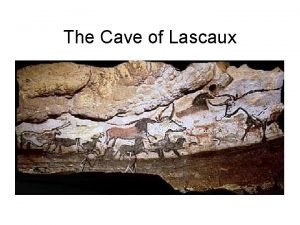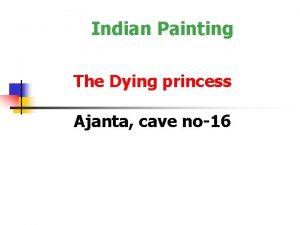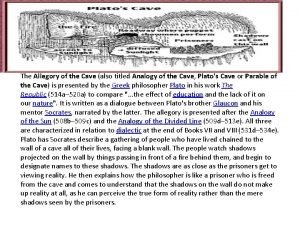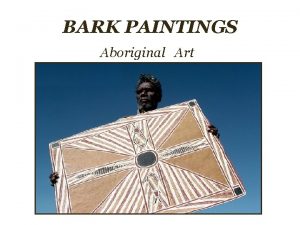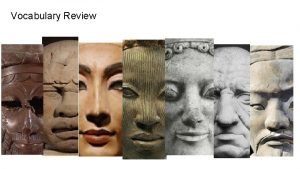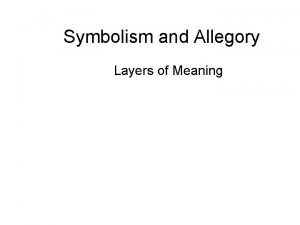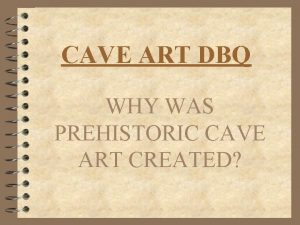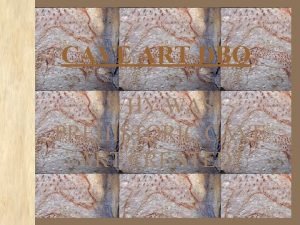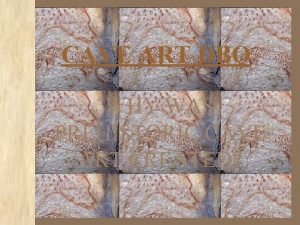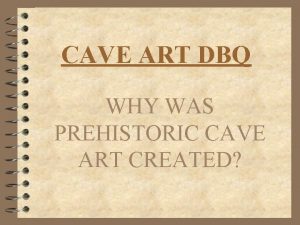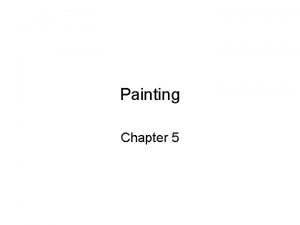Cave Art A History of Cave Painting What













- Slides: 13

Cave Art (A History of Cave Painting)

What are we talking about? Parietal Art Mobiliary Art ▪ Any prehistoric art found on cave ▪ Portable prehistoric art walls or large rock slabs ▪ Engraved and/or painted ▪ Jewelry, statuettes, carved spear throwers ▪ Bones, antlers, stones, seashells, eggshells ▪ Hard to date

How old is this stuff? Is it art? >290, 000 BCE 60, 000 BCE >39, 000 BCE >37, 900 BCE 37, 000 BCE • Bhimbetka petroglyphs • quartzite caves in India • context dating • La Ferrassie Cave cupules • Neanderthal burial slab • context dating • El Castillo red ochre disk • Uranium / Thorium dating • Sulawesi hand stencil • Uranium / Thorium dating • Gibraltar’s tiny engravings • Neanderthal site • AMS dating

How old is this stuff? And where’s Waldo? >35, 300 BCE 35, 000 BCE >34, 000 BCE >33, 400 BCE • El Castillo hand stencils • Uranium / Thorium dating • Fumane Cave paintings • figurative • carbon and stratigraphic dating • Abri Castanet (France) vulva petroglyphs • adjacent debris dating • Altamira Cave claviforms • Uranium / Thorium dating • Sulawesi babirusa • Uranium / Thorium dating

Chauvet Cave • 30, 000 BCE • over 300 paintings and engravings grouped in murals and panels • black or red monochrome • rhinos, mammoths, lions, horses, bison, reindeer, muskoxen, large cats, cave bears, an owl • geometric symbols, hand stencils, and handprints • cave was not used for regular habitation

Chauvet Cave

Lascaux Cave • 17, 000 BCE • 240 meters in length • 900 images of animals and over 1, 000 geometric symbols • many polychromatic images • rare painting of a human • bulls, horses, bison, aurochs, rhino, birds, stags, lions • spray painting technique used throughout the cave • “sockets” for scaffolding that provided access to the ceiling

Lascaux Cave


Pigments • Minerals for pigments were mined from as far as 25 miles away. • Minerals were ground, then mixed with water or urine for fluidity and with vegetable oil, animal fat, blood, or bone marrow as a binding agent. • Less permanent pigments (from plant and animal sources) were used for cave and body painting. Color Source White calcite; kaolin Yellow ochre limonite; goethite Red ochre hematite Umber mixture of iron and manganese Black charred bones, burnt wood, manganese

Application Spray paint. Artists spat paints either directly onto the surface or through hollow reeds or bones. Crayons. Pigments were formed into a thick paste and then molded into crayon shape. Brushes, etc. Artists applied paint using moss, wads of animal fur, and brushes made from horsehair. Engravers. Artists incised outlines and details using chiseled flints, often after the paint was applied to the cave wall.

Why? To kill time. To tell stories. To draw maps. To convey ownership. For ritual and ceremonial use.

The End. Need more? http: //www. visual-arts-cork. com/prehistoric-art. htm
 Cave painting symbols
Cave painting symbols Ajanta caves paintings dying princess
Ajanta caves paintings dying princess Art that breaks the rules, artifice over nature
Art that breaks the rules, artifice over nature Allegory of the cave fahrenheit 451
Allegory of the cave fahrenheit 451 Cave art definition
Cave art definition Bark painting
Bark painting Sedlabanki is gengi
Sedlabanki is gengi Oil paint history
Oil paint history Bear hunt long wavy grass
Bear hunt long wavy grass Taino art dominican republic
Taino art dominican republic When was basketball invented
When was basketball invented Visiting hour bbc bitesize
Visiting hour bbc bitesize Allegory of the cave meaning
Allegory of the cave meaning The highest of the forms in real world are
The highest of the forms in real world are
